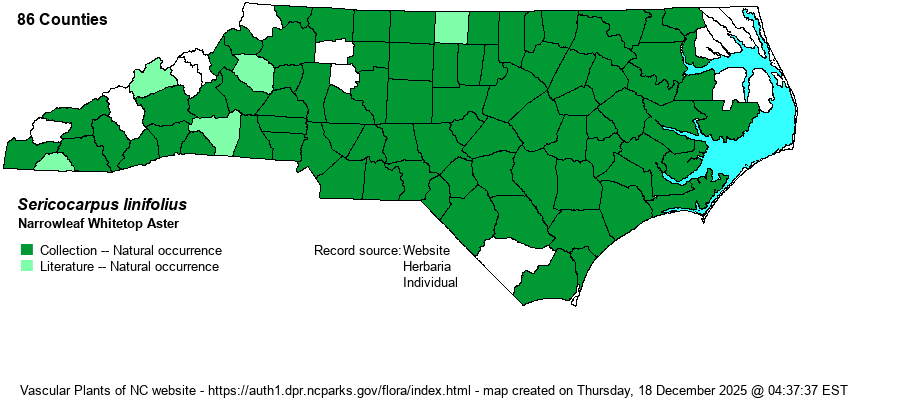| Author | (L.) Britton, Sterns, & Poggenburg | |
| Distribution | Essentially throughout the state, but scarce in the Mountains and apparently absent from the northeastern corner.
MA to southern IN, south to central GA and southeastern LA. | |
| Abundance | Common over the Piedmont and most of the Coastal Plain; infrequent in the southern Mountains, but absent in the northern half. Rare to absent in the northeastern Coastal Plain. | |
| Habitat | Dry to mesic soils of a wide variety of woodlands, such as pine-oak-hickory, oak-hickory-dogwood, Longleaf Pine-oak-Wiregrass (mostly in loamy sand), forest openings, rocky or gravelly slopes, rock outcrops. Usually in partial shade; habitats are nearly the same as for the similar S. asteroides. |
| Phenology | Flowering and fruiting June-July. | |
| Identification | Our four species of "whitetop aster" used to be included in the genus Aster. In the field they have a distinct gestalt, due to far fewer ray florets per head (maximum of 6), and these are always white. Narrowleaf Whitetop Aster typically grows 1-2 feet tall, with linear, parallel-sided leaves that are characteristically thick, shiny, and dark green above; basal leaves have withered by flowering time. The ray florets are narrower and much longer than in our other three species. All four species in the genus are common within much of their ranges, and people should easily become familiar with each one. | |
| Taxonomic Comments | Formerly treated as Aster solidagineus.
| |
| Other Common Name(s) | Flaxleaf Whitetop Aster | |
| State Rank | S5 | |
| Global Rank | G5 | |
| State Status | | |
| US Status | | |
| USACE-agcp | | |
| USACE-emp | | |

